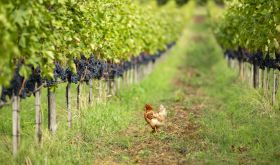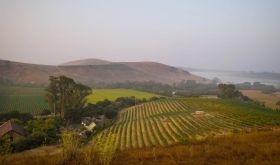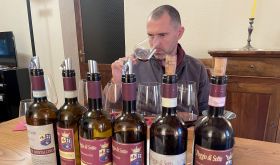It’s relatively easy to write about wine regions in their heyday, when prices are high and demand outstrips supply, quality is glowingly good and the future is radiant. There is a real buzz to writing about wine regions that are new, emerging and upcoming, where the pioneering spirit is palpable and where the sense of adventure is infectious.
It’s not so easy to write about wine regions that are battle-scarred and bruised, have struggled and are still struggling, that have potential but for the large part refuse to recognise what needs to change in order to reach that potential. It takes guts, perseverance, huge commitment, and the humility to eschew the glamorous regions in order to dedicate a huge amount of time to digging under the often thick and resistant skin of these regions in order to find the real story and uncover the beauty.
With a degree in botany and a PhD in plant sciences, Caroline Gilby MW became a trainee wine buyer in 1988. ‘Eastern Europe wine was massive business in the UK in the late 1980s, though it was distinctly the least glamorous part of the wine portfolio. As the most junior member of the buying team [at Augustus Barnett], that’s where I began. I started in 1988, just as the Iron Curtain began its fall.’
This book is a culmination of three decades tasting, buying, travelling to and writing about the wines of Eastern Europe, although Gilby is far from a one-trick pony. She became an MW in 1992 and has been an independent consultant and wine writer since 1995. She teaches, lectures, judges, consults and writes for a dizzying array of organisations, journals, books and magazines. But it’s fair to say that Eastern Europe has become her speciality.
She’s picked three interesting countries to focus on. Each one is at a bit of a crossroads in terms of wine, but the journey they’ve been on to get there is largely unknown to the western world, and the direction they take may well depend on how much notice the west takes of them. So this book could well be one of the key influences on their futures.
‘The mysterious eastern end of Europe is a landscape with an authentic history, unique grape varieties and something genuinely different and exciting to offer the wine world’, Gilby writes. ‘This book aims to explain that authenticity, and the history and geopolitical landscape that have influenced the wine producers of these countries.’ It wasn’t until I started reading these histories that I fully grasped exactly how important it is to understand how and why regimes such as the Ottoman Empire and communism, both of which Bulgaria, Romania and Moldova were subjected to, powerfully shape the landscape, the culture, and the ability of people to thrive. One simply cannot look at their wine industries today, and one cannot invest in their wine industries of the future, without looking at that context.
Each country is tackled separately, so you could really approach this as three smaller books – although they are interconnected and it’s worth reading the whole book through from start to finish, as one builds on another. In good Infinite Ideas form, there is a bit of background, history, landscape and grape varieties before a series of well-chosen producer profiles.
Each country has a long and rich history of winemaking and wine drinking – longer than I’d realised. In Bulgaria grape pips were found at Neolithic sites dating back to 6000 BC and the Thracians, famous for their ‘sweet wine of Thrace’, inhabited the region from about 1000 BC. Grapevine fossils in Moldova date back 10 million years. Romans, kings and writers eulogised the wines from the countries throughout the ages. It was the Ottoman Empire that struck the first deep blow to wine growing, resulting in the loss of centuries of knowledge, tradition, land ownership, vines and markets. As they recovered from this, and started to rebuild, the second blow was phylloxera, the third was the First World War, then the Second World War, and then communism.
Gilby quite rightly states that, ‘In the west, we have often been guilty of seeing Eastern Europe’s recent past as a single homogeneous mass of grim Eastern Bloc greyness’. What’s particularly interesting in her book is how differently each country has been shaped by and responded to the traumas it has been through. Each has emerged with its unique strengths and different challenges; despite being a part of the ‘homogeneous mass’ of communism, each country has developed a distinct identity.
The stories of how land was ripped up, grubbed up, stolen from the people who loved and worked it, carved up, pounded into industrial grape-producing factories, abused, then carved back up into tiny meaningless pieces and handed to people with no money, who’d lost their knowledge, instinct, tradition and connection to it, are stories that more than once drew tears to my eyes. Gilby writes with compassion, but spares us maudlin sentiment. It’s no wonder that there are major flaws and big obstacles to be overcome, and she identifies these without pity, but is equally quick to praise, to find the best, to shine a light on the potential, and to suggest practical, intelligent and well-informed solutions.
She takes a bleak, hard, bare-bones look at each country and its wine industry, but the real hope lies in the producer profiles. Gilby has taken the time to find the people who, given enough support, are going to bring about revolution – peaceful, wine-soaked revolution. Although she presents tremendously well-researched, painstaking, immaculate (and fascinating) detail about grape varieties, terroir, climate, education, history, economics, politics, EU, regulations and government, it’s clear that it’s the people with vision and courage and, dare I say it, passion, who are going to change things bit by bit. People who are unafraid to start small and keep going even when the odds are firmly against them. They are cardiac surgeons and lawyers, rubbish collectors and princes, ex ministers of justice, Italians, Swiss, Poles, Germans and a man from Bristol. They are the people blowing up Soviet concrete tanks with the help of the Romanian army, and people building tasting rooms inside Soviet concrete tanks. They are the people who fell in love with locals, who wanted childhood memories restored, who were too lazy to study music so picked oenology as an easy option. They are the people running the largest single vineyard in Europe (with a bakery and dairy on site to feed the staff and 26 vineyard managers) and the young couple managing 17 ha (42 acres) by themselves. They are the people going green, making orange wine and reviving ancient grapes.
The Wines of Bulgaria, Romania and Moldova is one of the most unflinchingly honest wine books I have ever read. This is no starry-eyed account from a newbie fan who’s spent a couple of months in an undiscovered region. This is the kind of book that can be written only by someone who has worked with the regions for 30 years, cares deeply about them, wants to see them thrive, but also sees and has the courage to point out what is wrong. She is not afraid to be critical – very critical in places – but at no point do you get a sense of someone trying to expose vulnerabilities for a good storyline. Instead, everything about the book reads a bit like tough love. Gilby has the piercing insight of someone with a scientist’s brain and a mother’s heart.













